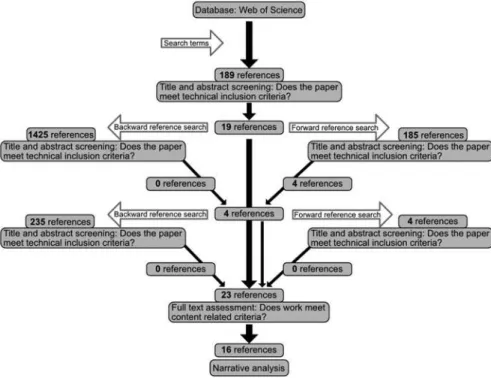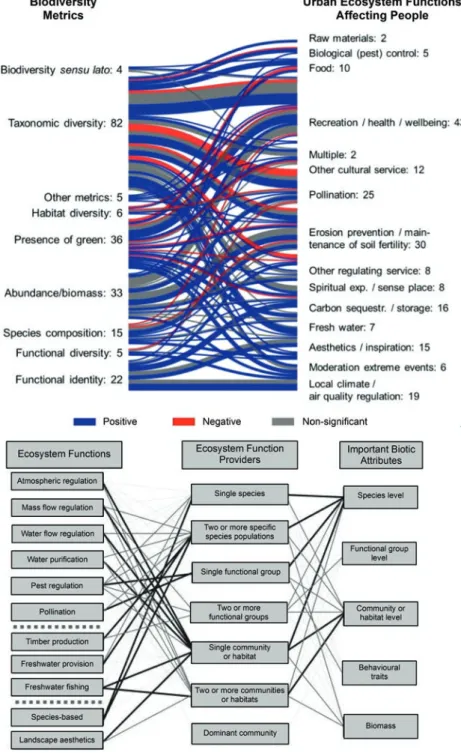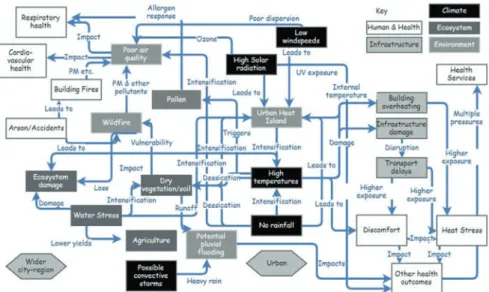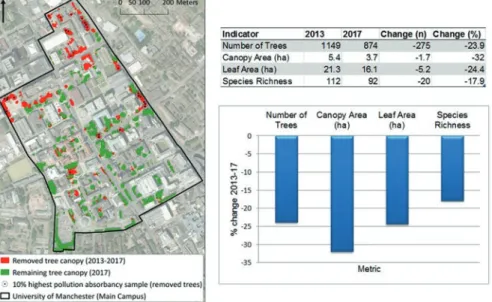This volume contributes significantly to the knowledge base to show the interlinkages between biodiversity and health in a changing climate. This book would not have been possible without the collective expertise and understanding of the various interrelated issues of biodiversity and health in the face of climate change.
Editors
Aletta Bonn, Professor of Ecosystem Services at the Friedrich Schiller University Jena in Germany and head of the Ecosystem Services Department at the Helmholtz Center for Environmental Research Germany (UFZ) and the German Center for Integrative Biodiversity Research (iDiv). With a working background at the interface between science and policy in the UK and Germany, her research focuses on ecosystem services, biodiversity and human well-being, participatory conservation and citizen science.
Contributors
Raymond De Young Associate Professor of Environmental Psychology and Planning at the University of Michigan, USA. Matthew Dennis Lecturer in Geographical Information Science in Geography at the University of Manchester, UK.
Biodiversity and Health in the Face of Climate Change: Challenges,
Background
The work with NBS shows the importance of green areas for adaptation and mitigation of climate change (Kabisch et al. 2017). Biodiversity supports ecosystem services essential to human health and well-being (Cardinale et al. 2012).
Scope of the Book
Specifically, this book identifies not only the contribution of biodiversity to physical health, but also to mental and spiritual health and well-being in the face of climate change. The scope of this book is the contribution of biodiversity to physical, mental and spiritual health and well-being in the face of climate change.
Structure and Contents of the Book
- Part I: Biodiversity and Physical Health
- Part II: Biodiversity, Mental Health and Spiritual Well-Being
- Part III: Implications of the Biodiversity and Health Relationship
- Part IV: Planning and Managing Urban Green Spaces for Biodiversity and Health in a Changing Climate
The final chapters review the evidence on the impact of biodiversity on mental health and spiritual well-being. Complementing this chapter, Ruth Hunter and co-authors discuss the effectiveness of urban green space interventions for improving health and biodiversity and make recommendations for research, policy, and practice.
Lovell R, Wheeler BW, Higgins SL, Irvine KN, Depledge MH (2014) A systematic review of the health and well-being benefits of biodiverse environments. Watts N, Adger WN, Agnolucci P et al (2015) Health and climate change: policy responses to protect public health.
Biodiversity and Physical Health
Biodiversity, Physical Health and Climate Change: A Synthesis of Recent Evidence
Introduction
Biodiversity is considered one of the underlying requirements for the beneficial functioning of ecosystems for human health and well-being and as such is entrenched in policy-oriented arenas (Lovell et al. 2014; Sandifer et al. 2015). Third, we provide an overview of some of the important ways in which climate change affects physical health and the natural environment, including through biodiversity (see section 2.4).
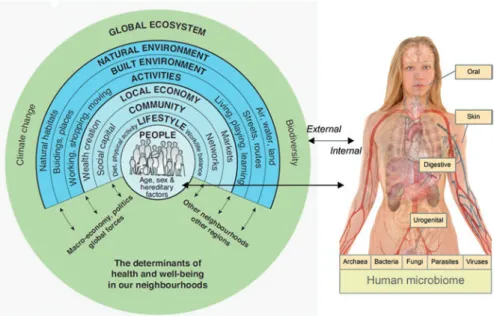
Nature’s Contributions to Physical Health
Some of the published evidence relates to effects seen as a result of simply being in 'natural' spaces (Haluza et al. 2014). Brassica vegetables are associated with anti-cancer properties as well as a number of other health benefits (Moreno et al. 2006).
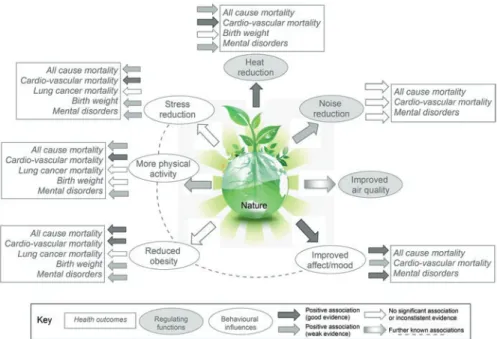
Biodiversity and Physical Health
In turn, biodiversity ultimately affects human health by making agricultural systems inherently more resilient and less vulnerable to large-scale losses (Dobson et al. 2006). Evidence also suggests a link between biodiversity and the productivity of systems for human use, for example, more biodiverse forests and fisheries are more productive for fuel and food (Harrison et al. 2014).
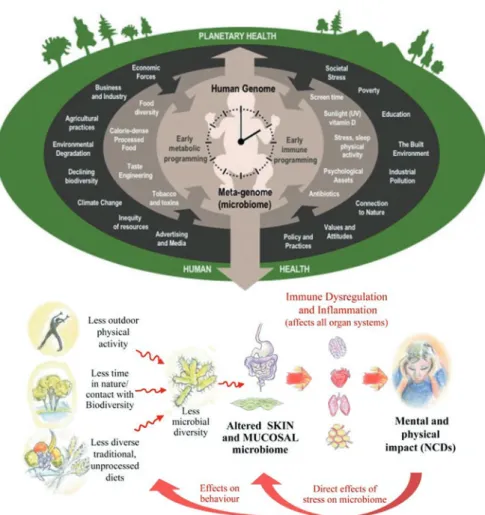
Climate Change and Physical Health
Although changes in influenza peaks and seasons have been observed, climatic and other determinants are currently uncertain (Caini et al. 2018). The stagnation events associated with air quality episodes may also be associated with summer heat waves and thus have cumulative outcomes for human health (Doherty et al. 2017).
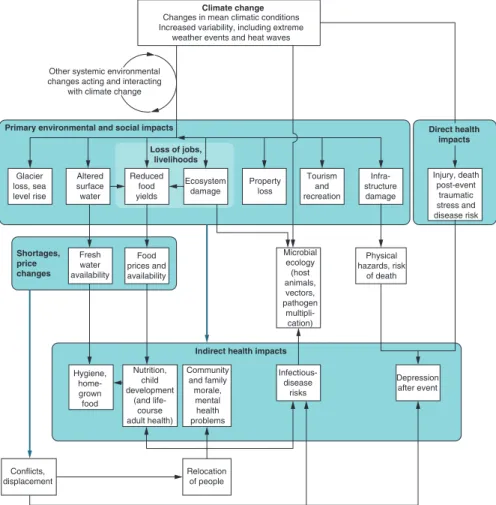
Exploring a Subset of Interactions Through an Urban Case Study
The neighborhood could also see an increase of up to 3.4 °C (2.4 °C) in the temperature of the hottest summer day (night), according to the central estimate of the UKCIP09 projections (high emissions scenario) with these highest increases expected for the upland Pennine fringe (Cavan 2010). At least one industrial fire occurred in Rochdale to the north-east of the borough.
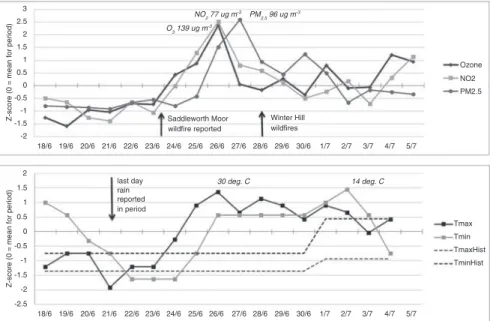
Conclusion
Uncertainties remain about some of the evidence for links between biodiversity, human physical health and climate change. Lovell R, Wheeler BW, Higgins SL, Irvine KN, Depledge MH (2014) A systematic review of health and well-being.
Climate Change and Pollen Allergies
- Introduction
- Clinical Implications of Pollen-induced Respiratory Allergy
- Allergenic Pollen and Epidemiology
- Adjuvant Factors from Pollen and Impact of Environmental Factors
- New Pollen Allergies: The Case of Ragweed
- Climate Change Effects
- Pollen Information Services
- Conclusions and Future Challenges
Gilles S, Fekete A, Zhang X et al (2011) Pollen metabolome analysis reveals adenosine as a key regulator of dendritic cell-prone T(H) cell responses. Troise C, Voltolini S, Delbono G et al (1992) Allergy to pollens from Betulaceae and Corylaceae in a Mediterranean area (Genoa, Italy).
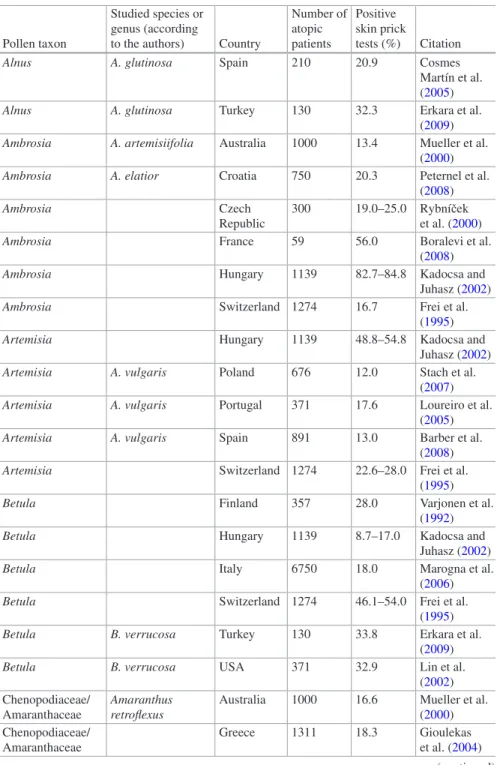
Vector-Borne Diseases
Triple Vulnerability: Climate Change, Biodiversity and Vector-Borne Diseases
Climate and biodiversity change has health impacts that vary widely from direct effects such as progressive temperature increases from global warming, flooding or heat waves due to increased climate variability and extreme weather events, to indirect effects such as changes in ecosystem services, food productivity or species distributions (Montag et al. 2017). VBDs are clearly highly intertwined with climate change and the extent of biodiversity (Engering et al. 2013).

Disease-Transmitting Mosquitoes and Ticks
- Influence of Temperature on Vector Mosquitoes and Associated Pathogens
- Distributional Changes of Mosquito Vector Species
- Distributional Changes of Ticks in Europe
In arboviruses, temperature affects plaque growth (Jia et al. 2007) and replication rate (Kilpatrick et al. 2008). There are objective reasons why climate change affects the distribution and seasonal activity of disease-transmitting ticks (Ogden et al. 2014).
Biodiversity and VBDs: The Large Unknowns .1 Pathogen Diversity
- Vector Diversity
- Host Diversity
However, large knowledge gaps still exist regarding the diversity of reservoir hosts for mosquito- and tick-borne pathogens in old and new distribution areas (Baráková et al. 2018; Hashiguchi et al. 2018). This model also applies to other vector-host systems where a generalist vector uses many host species, only a few of which are competent reservoir hosts (Swaddle and Calos 2008; Civitello et al. 2015).
How to Manage VBDs?
- Chemical Insecticides
- Biological Insecticides
- New Genetic Tools in Vector Control
- Sustainable Control Programs
This theoretically self-sustaining Wolbachia method is now in the large-scale trial phase (reviewed in Mishra et al. 2018). Vu etc. 1998) and are now also proposed as biological agents against Culex mosquitoes.
Responses to VBDs Along with Biodiversity Loss and Climate Change
- Target the Complexity
- Interconnecting People and Knowledge
- Policy Options
Friederike Reuss is funded by the Hessian Center on Climate Change of the Hessian Agency for Conservation, Environment and Geology. Montag D, Kuch U, Rodriguez L, Müller R (2017) Overview of the panel on biodiversity and health under climate change.
The Influence of Socio-economic and Socio-demographic Factors
Introduction
Interest in research has recently increased regarding the role that urban green spaces can play in improving the health of urban residents (Hartig et al. 2014). In particular, the effects of urban green spaces on urban health, depending on accessibility and socio-economic status/trends, are investigated.
Methods
This suggests a more complex relationship between availability and accessibility of urban green spaces and socio-economic differences, which depends on the indicators used to measure greenness, availability and quality characteristics of urban green spaces. The term 'socio-economic confounder' is used in this chapter to describe factors that have a potential impact on health and may even nullify a possible link between urban green space and health outcomes.
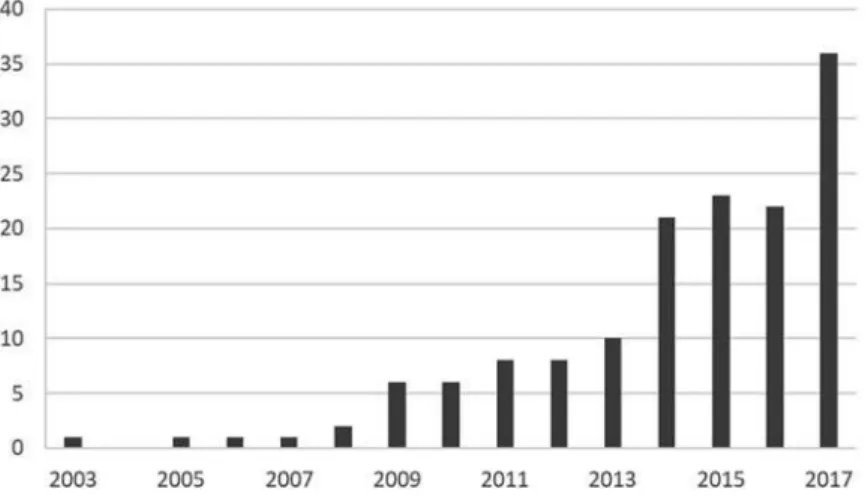
Results
- Mental Health and General Health
- Birth Outcome
- Overweight
- Physical Activity, Cardiovascular Disease and Mortality
- Green Space Metrics, Buffers and Data Used
- Confounding Factors
Association between green space and stress became non-significant after adjustment for confounders (Cusack et al. Padilla et al. 2016) showed that the significant association between green space and stress disappeared when models were adjusted for socio-economic confounders.
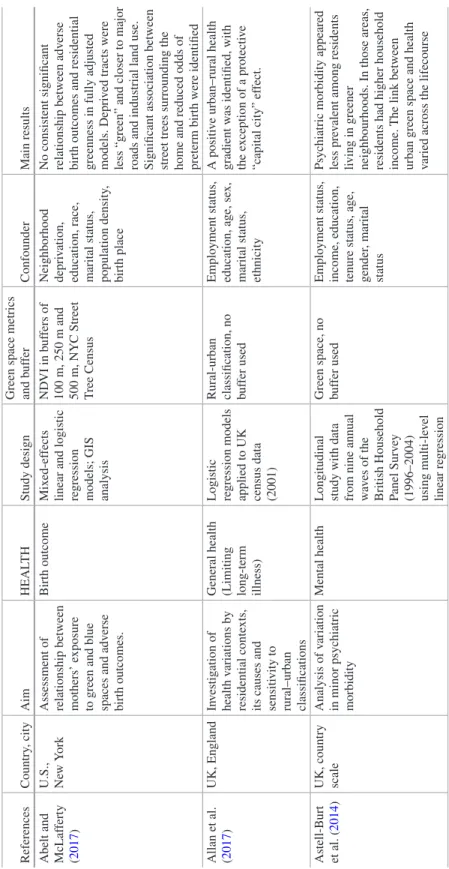
Discussion
- Urban Green Space and Health Outcomes in Relation to Socio-demographic and Socio-economic Confounders
- Implications for Urban Policy and Planning
- Directions for Future Research
Furthermore, the mediating effect of urban greenery was highlighted for lower-income or disadvantaged groups (Flouri et al. Some relationships between greenery and health seemed to be stronger for people living in low-income areas (Xu et al. 2017).
Conclusion
Cusack L et al (2017) Associations between multiple green space measures and birth weight across two US cities. Thompson CW et al (2016) Mitigating stress and supporting health in deprived urban communities: the importance of green space and the social environment.
Green Spaces and Child Health and Development
- Potential Mechanisms
- Pregnancy and Childhood as Important Windows of Vulnerability
- Pregnancy Outcomes and Complications
- Brain Development
- Respiratory and Allergic Conditions
- Cardiometabolic Risk Factors
- Final Remarks
The available evidence on the effects of green spaces on asthma and allergic conditions in children is inconsistent (Lambert et al. 2017). Dadvand P et al (2018b) Green space use and blood glucose in children; a population-based study CASPIAN-V.
Biodiversity, Mental Health and Spiritual Well-being
Theoretical Foundations of Biodiversity and Mental Well-being Relationships
Introduction
Biodiversity also helps to mitigate the negative effects of climate change on human health (see Lindley et al. However, biodiversity (with climate change) can also harm human health by dispersing pollen and increasing contact with disease-carrying organisms (Vaz et al.).
Environmental Preference
- Aesthetic Model of Preferences
- Preference Matrix
- Connection to Biodiversity in the Preference Matrix
- Fractal Geometry and Visual Fluency
- Connection to Biodiversity with Fractals
- Fractal Dimension and Preference
- Fractal Dimension and Restorative Outcomes
- Biophilia Hypothesis
- Connection to Biodiversity in the Biophilia Hypothesis
Further support for the preference for mid-range D scores was found in the study by Bies et al. (2016) that examined preferences for statistical (fractals that do not repeat exactly but have the same statistical properties as they occur in nature) or exact (fractal patterns that repeat exactly, created by a computer program) fractals. The biophilia hypothesis emphasizes people's positive response to nature, which may manifest itself in a preference for specific animals, plants or environments (Hartig et al. 2011).
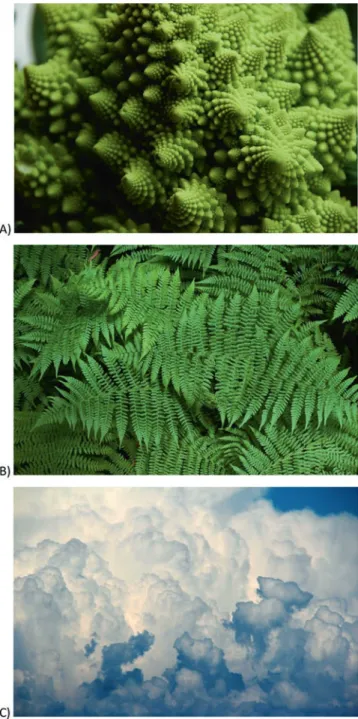
Theories of Restorative Environments
- Stress Reduction Theory (SRT)
- Connection to Biodiversity in the SRT
- Attention Restoration Theory (ART)
- Connection to Biodiversity in the ART
Biodiversity was not a concept used in the original theoretical writings of RTSH. Most strikingly, coherence was rated significantly lower in the desert environment compared to the other three landscapes (see Fig. 7.3).
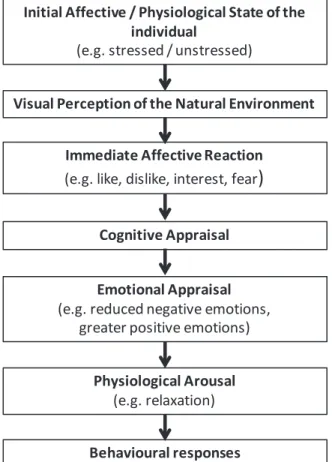
Ecosystem Services Cascade Model
- Connection to Health and Well-being in the Ecosystem Service Cascade Model
Most research on the benefits of ecosystem services to human health and well-being focuses on the physical health benefits of providing and regulating ecosystem services (Sandifer et al. 2015). The exact chance pathways linking biodiversity to physical and mental health and well-being through the Cascade model are little understood (Sandifer et al. 2015).
Discussion
The Ecosystem Service Cascade Model discusses human health and well-being as benefits derived from biodiversity and ecosystem services (Haines-Young and Potschin 2010; Potschin and Haines-Young 2011), but little research links ecosystem services to human health and well-being (Sandifer et al.). But since biodiversity itself can occur at any stage of the Ecosystem Service Cascade Model, it is still unclear what the exact casual pathways are that link biodiversity to health and well-being (Sandifer et al. 2015).
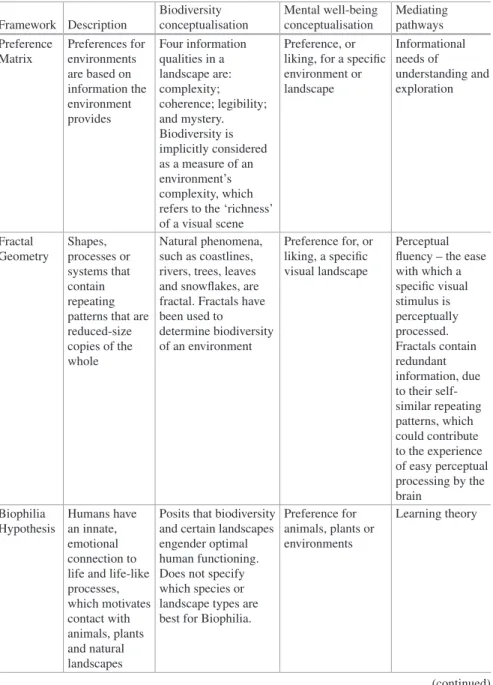
Biodiversity in the Context
Key Concepts
- Biodiversity
- Mental Health and Well-Being
- Linking Biodiversity to Mental Health: Research Questions and Conceptual Model
That is why we also discuss the concepts of mental health and mental well-being, albeit less extensively. When we use the term “mental health” throughout the remainder of this chapter, mental well-being is implied.
Measurement of Biodiversity
- Characteristics of Nature in General
- The Object to Be Assessed: The Biodiversity of What?
- How to Measure Distance?
- Aggregating Biodiversity Across Different Areas
- Type of Access Metric
- Actual Versus Perceived Biodiversity
- Access Versus Exposure, and Type of Contact
- Mediators, Confounders and Covariates
Another approach is to assess biodiversity at the level of the residential environment as a whole. Information on the level of biodiversity, in terms of species diversity, is not always available.
Concluding Remarks
Dallimer M, Irvine KN, Skinner AM et al (2012) Biodiversity and the well-being factor: understanding the links between human self-reported well-being and species richness. Tzoulas K, Korpela K, Venn S et al (2007) Promoting ecosystem and human health in urban areas using green infrastructure: a literature review.
Review of the Mental Health
Introduction
To date, only one systematic review has explicitly investigated the health and well-being benefits of contact with biodiversity (Lovell et al. 2014). Describe the state and nature of the body of evidence published since the review by Lovell et al. 2014), in relation to biodiversity with mental health and well-being;.
Methods
- Literature Review
- Characteristics of the Recent Literature
Biodiversity indicators were classified based on the levels of biodiversity identified by Botzat et al. 2016) – namely ecosystems/habitats (e.g. parks, forests); communities of species (eg plants, birds, butterflies); or individual species. Abundance may be more important for mental health or mental well-being than the number of different species (Dallimer et al. 2012).
